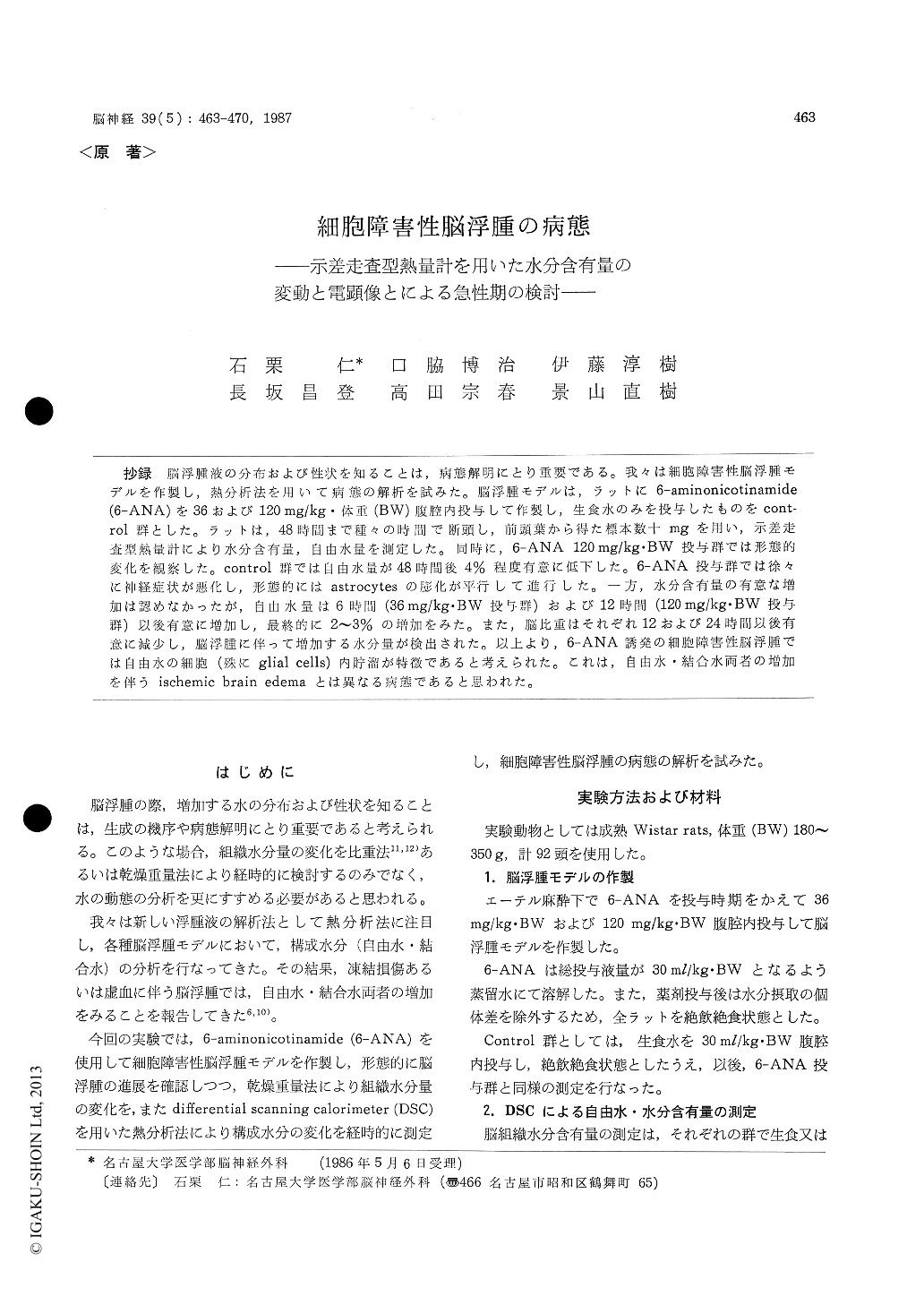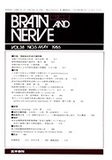Japanese
English
- 有料閲覧
- Abstract 文献概要
- 1ページ目 Look Inside
抄録 脳浮腫液の分布および性状を知ることは,病態解明にとり重要である。我々は細胞障害性脳浮腫モデルを作製し,熱分析法を用いて病態の解析を試みた。脳浮腫モデルは,ラットに6-aminonicotinamide(6-ANA)を36および120mg/kg.体重(BW)腹腔内投与して作製し,生食水のみを投与したものをcont-rol群とした。ラットは,48時間まで種々の時間で断頭し,前頭葉から得た標本数十mgを用い,示差走査型熱量計により水分含有量,自由水量を測定した。同時に,6-ANA 120mg/kg・BW投与群では形態的変化を観察した。control群では自由水量が48時間後4%程度有意に低下した。6-ANA投与群では徐々に神経症状が悪化し,形態的にはastrocytesの膨化が平行して進行した。一方,水分含有量の有意な増加は認めなかったが,自由水量は6時間(36mg/kg・BW投与群)および12時間(120mg/kg・BW投与群)以後有意に増加し,最終的に2〜3%の増加をみた。また,脳比重はそれぞれ12および24時間以後有意に減少し,脳浮腫に伴って増加する水分量が検出された。以上より,6-ANA誘発の細胞障害性脳浮腫では自由水の細胞(殊にglial cells)内貯溜が特徴であると考えられた。これは,自由水・結合水両者の増加を伴うischelnic brain edemaとは異なる病態であると思われた。
To understand the pathogenesis of brain edema, we studied distribution and constitutional changes of brain-tissue water by morphological and ther-moanalytical methods in cytotoxic brain edema induced by 6-aminonicotinamide (6-ANA).
Ninety-two Wistar rats were divided into three groups ; Group I rats receiving physiological salt solution intraperitoneally served as controls. Group II and III animals were intraperitoneally given 120 mg/kg and 36 mg/kg of 6-ANA respectively. All animals were starved after injection of drugs to exclude differences in water intake. Then they were decapitated at 3, 6, 12, 24, 36 or 48 hours to measure specific gravity (SG) of large brain tissue (1.1-1.5 g), and to evaluate water content (WC) and free water ratio (FWR) of small brain-tissue samples (15-35 mg) taken from the frontal cortex ; WC was measured by a drying-weighing method, and FWR was analyzed with a differential scan-ning calorimeter. Moreover morphological changes of the frontal cortex of the brain were studied in Group If (n=12) at 3, 6, 12, 24 and 48 hours with an electron microscope.
Neurological status of animals administered 6-ANA (Group II and III) deteriolated with time. Morphological studies showed that perivascular astrocytes and astrocytic processes in the cerebral cortex were swollen most remarkably at 48 hours.However neuronal and endothelial cells were al-most intact. The FWR of Group I decreased significantly about four per cent (p<0.001) after being starved for 48 hours. But the SG and WC of the group showed little change. In contrast with controls, the FWRs of 6-ANA injected ani-mals (Group II and III) gradually increased and reached to significant maximal values at 12 hours in Group II (p<0.05) and at 24 hours in Group III (p<0.001) respectively. The SGs of these two groups decreased significantly at 24 and 36 hours in Group II, and at 12 and 24 hours in Group III.However there were no significant changes of the WC in the experimental groups. Probably because brain-tissue water increased too little to be detec-ted by a drying-weighing method using such small samples.
It is concluded that 6-ANA induced brain edema is characterized by intraglial retention of free water component in the gray matter of the brain, in contrast with ischemic brain edema, in which both free and bound water increase together, as previously reported in our papers.

Copyright © 1987, Igaku-Shoin Ltd. All rights reserved.


